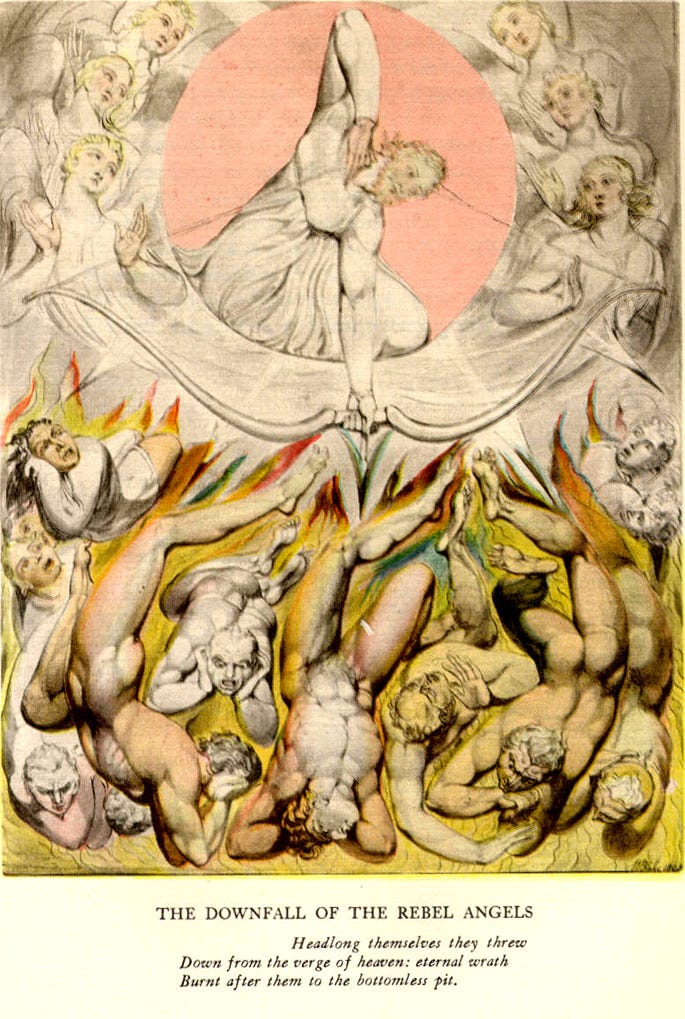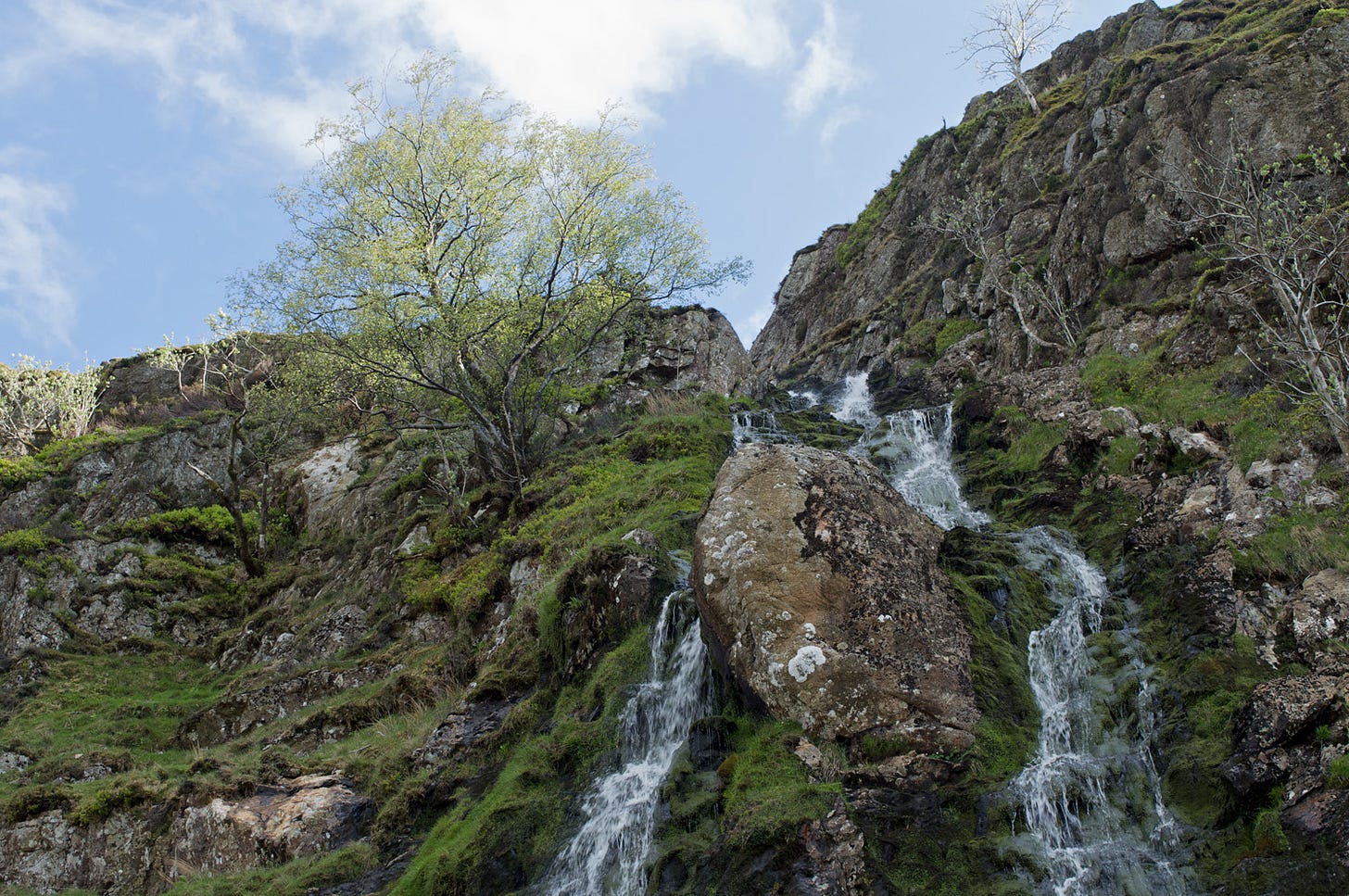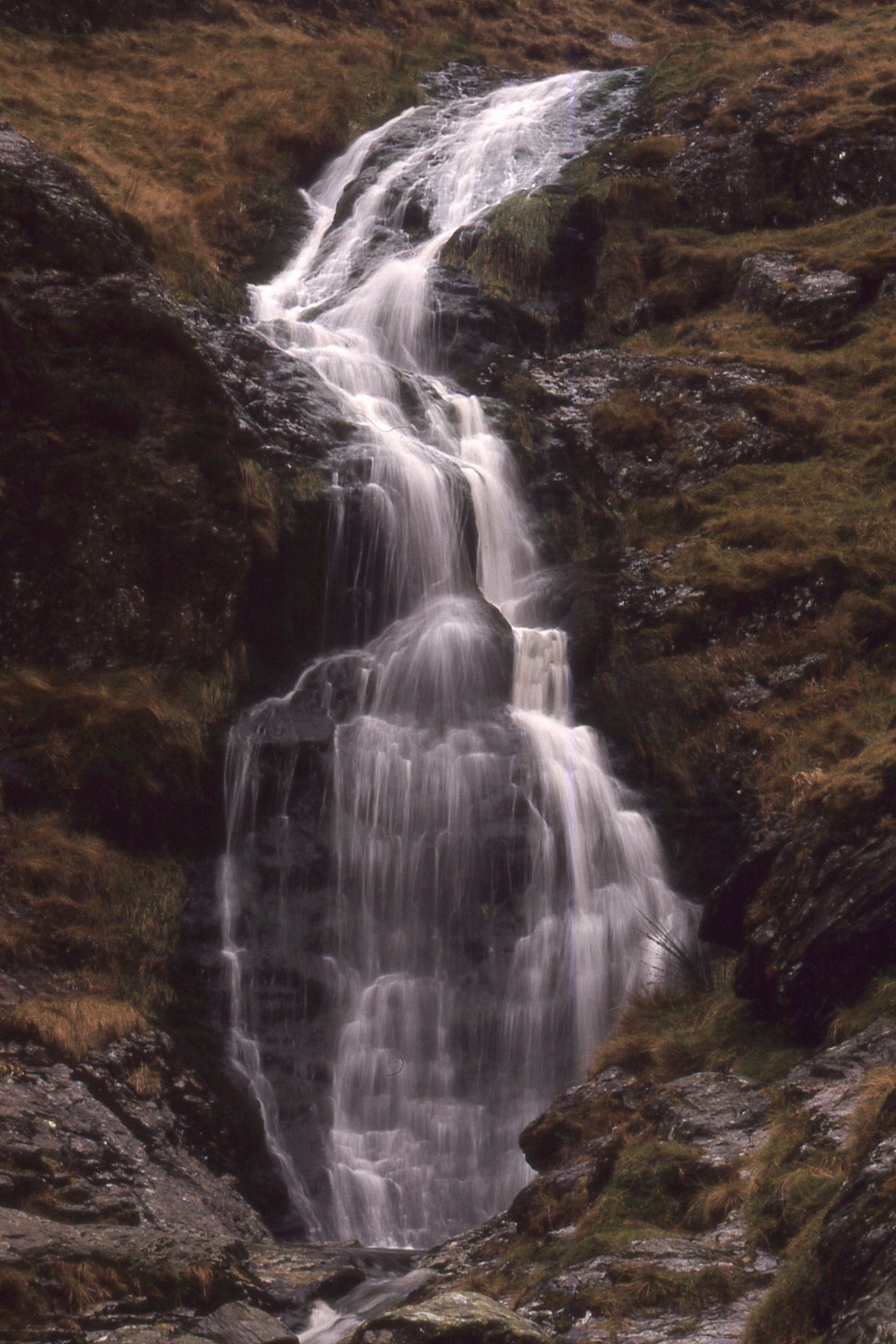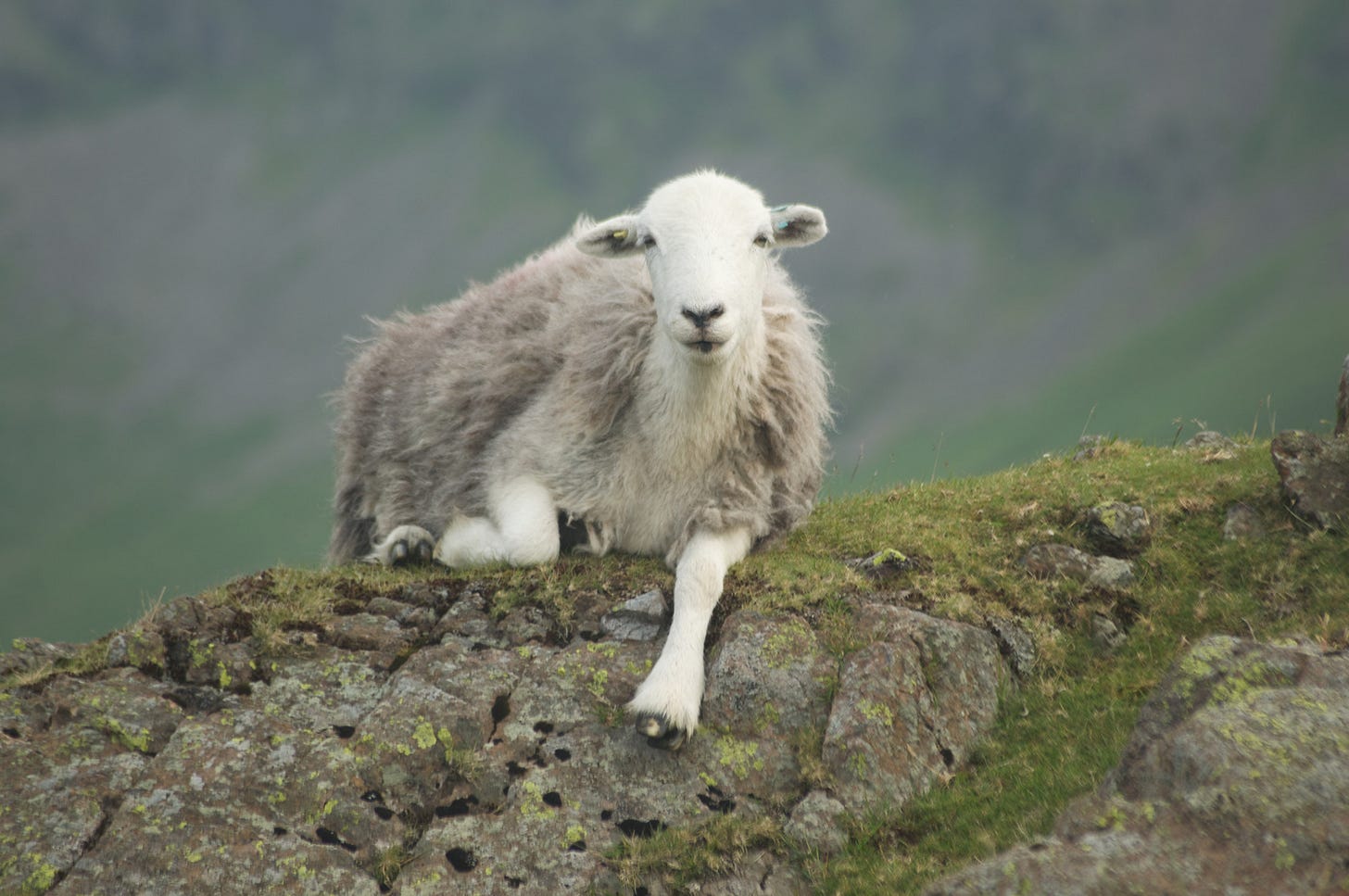The finest bit of Lakeland Writing so far
For any freelancer writing stuff about the Lake District hills today, it’s hard not to be intimidated by the poet Samuel Taylor Coleridge. The Moss Force waterfall's a bit intimidating too. [1000 word
Coleridge moved to Greta Hall in Keswick, in the year 1800, to be close to his friends William and Dorothy Wordsworth at Dove Cottage, Grasmere. All three of them were great fellwalkers – 30-mile-a-day men (except Dorothy, a 30-mile a day woman, of course).

In August of 1802 Coleridge packed a small knapsack, tore apart his wife’s besom broom to make a walking pole, and set off on a nine-day tour of the Lake District. In the course of it he would be served beer by the famed Maid of Buttermere, be disappointed by St Bees Abbey, make the first recorded ascent of Sca Fell, and get into a spot of bother on Broad Stand on the way down again.1
But on his first afternoon, crossing the Newlands Pass, he spotted a nice splashy waterfall. Not splashy enough – it hadn’t really been raining. So once he was home again he waited (not long: this is the Lake District) for a really wet day and walked out again the six miles from Keswick.
Coleridge at Moss Force
Letter to Sara Hutchinson
from Greta Hall, Keswick, 25th August 1802, and early September 1802
I had a glorious walk – the rain sailing along those black crags and green steeps, white as the wooly down on the under side of a willow leaf, and soft as floss silk. Silver fillets of water down every mountain from top to bottom that were as fine as bridegrooms. I soon arrived at the Halse [Newlands Hause pass] and climbed up by the waterfall as near as I could, to the very top of the Fell. But it was so craggy – the crags covered with spongy soaky moss, and when bare so jagged as to wound one's hands fearfully – and the gusts came so very sudden and strong, that the going up was slow, and difficult and earnest – and the coming down, not only all that, but likewise extremely dangerous. However, I have always found this stretched and anxious state of mind favourable to depth of pleasurable impression, in the resting places and lownding [sheltering: STC's italics] coves. The thing repaid me amply: it is a great torrent from the top of the mountain to the bottom. The lower part of it is not the least interesting, where it is beginning to slope to a level – the mad water rushes through its sinuous bed, or rather prison of rock, with such rapid curves, as if it turned the corners not from the mechanic force, but with foreknowledge, like a fierce and skilful driver. Great masses of water, one after the other, that in twilight one might have feelingly compared them to a vast crowd of huge white bears, rushing, one over the other, against the wind – their long white hair shattering abroad in the wind.
The remainder of the torrent is marked out by three great waterfalls – the lowermost apron-shaped, and though the rock down which it rushes is an inclined plane, it shoots off in such an independence of the rock as shews that its direction was given it by the force of the water from above. The middle, which in peaceable times would be two tinkling falls, formed in this furious rain one great water-wheel endlessly revolving and double the size and height of the lowest. The third and highest is a mighty one indeed; it is twice the height of both the others added together, nearly as high as Scale Force, but it rushes down an inclined plane – and does not fall, like Scale Force. However, if the plane had been smooth, it is so near a perpendicular that it would have appeared to fall – but it is indeed so fearfully savage, and black, and jagged, that it tears the flood to pieces – and one great black outjutment divides the water, and overbrows and keeps uncovered a long slip of jagged black rock beneath, which gives a marked character to the whole force. What a sight it is to look down on such a cataract! – the wheels, that circumvolve in it – the leaping up and plunging forward of that infinity of pearls and glass bulbs – the continual change of the Matter, the perpetual sameness of the Form – it is an awful Image and Shadow of God and the World. When I reached the very top, where the stream flows level, there were feeding three darling sheep, with their red ochre letters on their sides, as quiet as if they were by a rill in a flat meadow, flowing clear over smooth tressy water-weeds, and through by long grass – Bless their dear hearts what darlings mountain sheep are!...
In a later letter he rates Moss Force against the other two main Lakeland waterfalls:
I went to Lodore2 on Sunday – it was finer than I had ever seen it before. Never were there three waterfalls so different from each other, as Lodore, Buttermere Halse Fall [ie Moss Force], and Scale Force. Scale Force is a proper fall between two very high and narrow walls of rock, well tree'd – yet so that the trees rather add to, than lessen the precipice walls3. Buttermere Halse Fell is a narrow, open, naked torrent with three great water-slopes individualised in it one above another, large, larger, largest. Lodore has its walls, but they are scarcely walls, they are wide apart, and not upright, and their beauty and exceeding majesty take away the terror – and the torrent is broad and wide, and from top to bottom it is small waterfalls, abreast, and abreast. Buttermere Halse Fall is the War-song of a Scandinavian Bard. Lodore is the Precipitation of the fallen Angels from Heaven, Flight and Confusion, and Distraction, but all harmonized into one majestic Thing by the genius of Milton, who describes it4. Lodore is beyond all rivalry the first and best thing of the whole Lake Country. Indeed (but we cannot judge at all from prints) I have seen nothing equal to it in the prints and sketches of the Scotch and Swiss Cataracts.
Moss Force is at the head of the Newlands Valley (grid reference NY193175). There is a convenient car park at the top of the pass Newlands Hause, on the small road between Derwent Water and Buttermere. Coleridge continued up vegetated rocks to right of the waterfall, a dodgy bit of scrambling that’s rather safer today with an intermittent path and cleaner rock.
Coleridge's wife was called Sara but these letters are to his lover, also called Sara. Sara ("Asra") Hutchinson's sister Mary married William Wordsworth later in 1802.
The Centre for English Romanticism (Coleridge as well as the Wordsworths, plus English Romantics still at it at today) is at Dove Cottage, Grasmere.
An article of mine about ST Coleridge's 9-day Lakeland walk of August 1802, during which he made England's first recorded rock-climb is on my own website: I just reformatted it to be reasonably readable also on your phone:
https://www.ronaldturnbull.co.uk/articles/colwalk/colwalk.html
Lodore Falls were pictured last week in a general waterfall roundup . https://aboutmountains.substack.com/p/watching-waterfalls
Coleridge had passed Scale Force (above Crummock Water, Buttermere valley) also on his 9-day backpack trip, 5 Aug 1802: "Scale Force, the white downfall of which glimmered through the trees, that hang before it like the bushy hair over a madman's eyes."
Paradise Lost Book I line 44
Him the Almighty Power
Hurld headlong flaming from th' Ethereal Skie
With hideous ruine and combustion down
To bottomless perdition, there to dwell
In Adamantine Chains and penal Fire,
Who durst defie th' Omnipotent to Arms.
Nine times the Space that measures Day and Night
To mortal men, he with his horrid crew
Lay vanquisht, rowling in the fiery Gulfe
Confounded though immortal.

Also Book VI line 860
[The] chrystal wall of Heav'n, which op'ning wide,
Rowld inward, and a spacious Gap disclos'd
Into the wastful Deep; the monstrous sight
Strook them with horror backward, but far worse
Urg'd them behind; headlong themselves they threw
Down from the verge of Heav'n, Eternal wrauth
Burnt after them to the bottomless pit.
– Milton didn't actually ever visit the Lake District of course.








